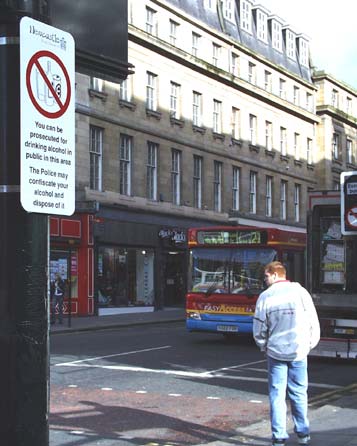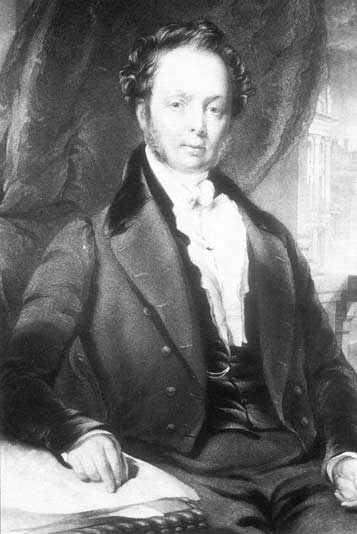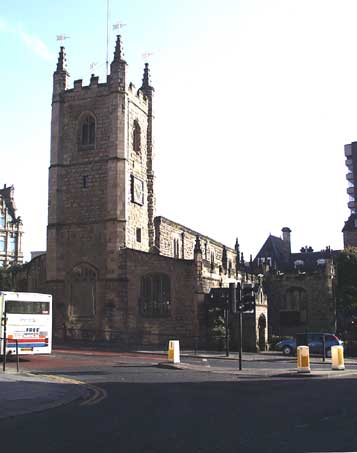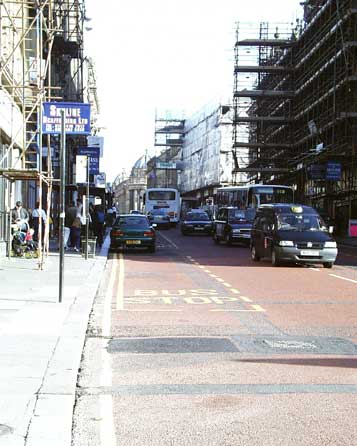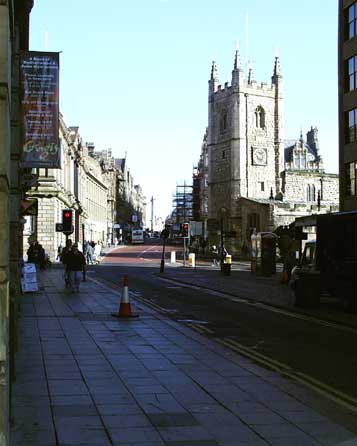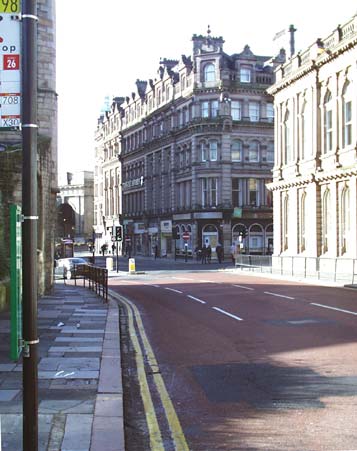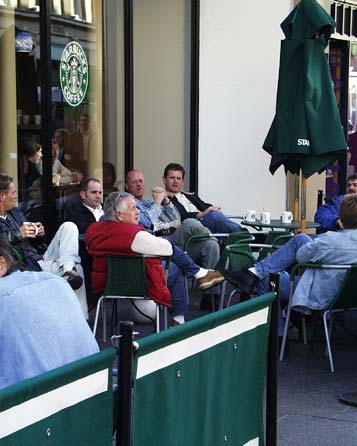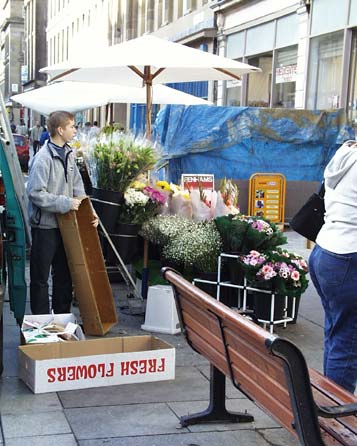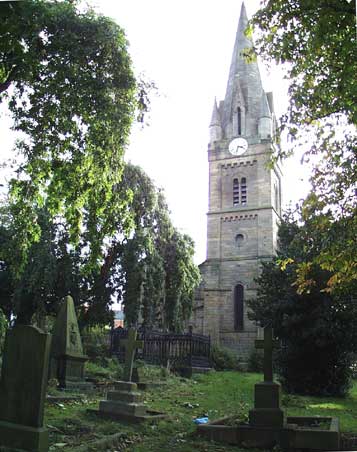|
|
|
City of Palaces
Sat. 6th October, 2001
|
|
 |
 |
"A citizen of Newcastle needs no reminder of the genius of Richard Grainger... the principal street in the
centre of the city is the most splendid and enduring monument to that genius."
This inscription in St. John's Church,
and a small public fountain in Waterloo Street were for over a hundred years the only public monuments to Richard Grainger. His life was dedicated to redeeming the city from the threat of becoming a
growling stinking smoking folly dedicated to the worst excesses of Victorian economic exploitation. |
 |
|
|
©1990 Newcastle upon Tyne City Library |
|
|
Grainger was born in 1797, in High Friar Lane, now covered by Eldon Square Shopping precinct. After school he was
apprenticed to John Brown a master carpenter and he was soon using his talents in rebuilding tumbledown properties on his own account and erecting new town houses in Higham Place.
His vision and
perseverance for a grand city centre design probably date from his seizing the opportunity to purchase a crumbling old estate in the centre, Anderson Place, following the death of the owner in 1831. He
combined with other notable and powerful people of his time including John Dobson and Thomas Oliver whose separate plans for the city were published in 1827, and put to the council in 1830.
Grainger's
genius was to combine the best of the ideas and actually do something, rather than talk. |
|
|
|
|
 |
 |
|
The south part of Grainger Street was determined by the 15th Century tower of St John's Church. The south boundary
is here Westgate Road, a road that predated Grainger's plan by many centuries. Grainger Street stretches from the Central Station, south of here, to Grey's Monument in the north.
Grey Street, Grainger
Street, and Blackett Street, come together in what was to be a central circus, but became the site of a magnificent column celebrating Charles Earl Grey of Howick Hall and the passing of the Great Reform Act.
Grainger Street is currently undergoing further cleaning and revitalisation. |
|
|
|
 |
 |
|
The building on the right in this picture, Victoria Chambers, whilst being intesively used on the ground floor for
retail, has lain unused for a decade since the legal profession decamped to the Quayside and Broad Chare development.
Beyond that, at the junction with Bigg Market, the old Bainbridges premises has been demolished, but the façade has been
retained behind those white sheets. A similar but less profound clean up is taking place on the left.
Further up, the domed triangular
Central Exchange gleams again after its facelift. |
|
 |
 |
|
In addition to the Grainger and Dobson architecture in this street, this ornate Gothic and Jacobean edifice is
Yates's Wine lodge. It was designed by John Johnstone in 1886 for the Newcastle Gas Company. One of Johntone's other existing buildings is
Leaze's Arcade, once a synagogue.
When first built, Grainger Street would have seemed spacious and wide when compared with the narrow oppressive lanes that existed before.
However, since the introduction of the motor car the scale of the thoroughfare has changed as the cars and people have to be separated. 500 people walking the street make it look empty. 35 motor cars fill up
the space and cause congestion. |
|
|
© Tyne & Wear Archive Service |
|
|
|
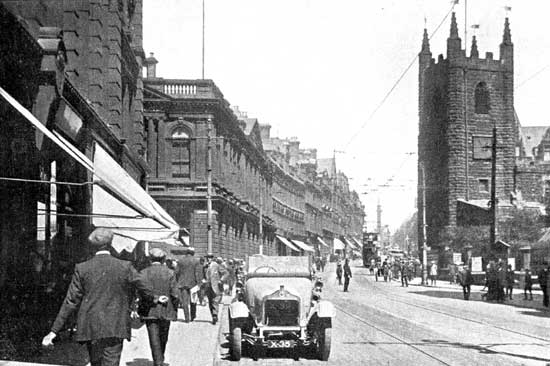 |
 |
|
Above is the view from the south looking up Grainger street in 1920. Only two motor cars are visible in this
typical scene. The prominent registration number X 35 belonged to the Duke of Northumberland. The bright summer sun was high in the sky, but in the custom of the time men wore hats and jackets. Shirtsleeves
would have been seen as rather rude in such a public place.
Today's view from the same spot shows a lower sun angle and a brief respite from traffic. The deep foreground shadows are cast by an ill
conceived massive concrete and glass box replacing the ornate Douglas Hotel. |
|
|
|
|
 |
 |
|
The opposite view shows the corner of the County Hotel building, erected in the 1840s following the opening of
Dobson's Central Station in the distance.
On the near right is the imposing Savings Bank building. On its front on Westgate Road the city arms adorn the pediment, the Grainger Street side includes a
decoration showing busy bees buzzing around the hive. This icon of thrift and the Victorian work ethic features strongly in the civic architecture of Manchester; Industrial powerhouse of the North West.
|
|
|
At the northern end of the street, from where the motor cars have been banished, pavement cafés invite a much more
slower pace. From here folk can relax and enjoy the shows and music often part of the Saturday scene under the monumnent. |
|
|
|
 |
 |
|
A number of street sellers have maintained their licences, and here this flower stall has been part of Newcastle
life at the entrance to the Grainger Market for decades.
The nearby shopfronts have been demolished and are currently being refaced in stone. Those blue sheets hide the stone cutter and mortar mixer.
Commerce is alive and well. The old Isaac Walton department store now houses a sports shop, a building society, high fashion, and even a branch of Anne Summers, a sexy underwear outlet. |
|
 |
|
The Isaac Walton name continues in a male outfitters a short distance on the opposite side of the street run by
John Rutherford, an ex department head at the old store.
Although a man with vision, Grainger was a property developer.
A complex web of speculative deals lay at the heart of all of his
activities, and John Clayton was his powerful Lawyer associate. That he was Town Clerk was not such a factor, his importance to Grainger was his fine legal mind. |
|
|
|
|
 |
Some of his plans were thwarted through opposition on the Council and he turned his attention to the Elswick estate
of John Hindle. Here, unrestricted by vested interest, he speculated £114,000 (£8.5 million in today's terms) of his own and borrowed money. He intended to live in Elswick Hall, improve it, develop the
nearby land then sell at a profit.
His plans for an industrial estate, shipping quay and rail terminus all needed further cash injections that he was unable to raise. This far sighted scheme was to be
realised 35 years later by Lord Armstrong and further fuelled by the First World War. |
|
 |
|
Grainger finally ran out of cash in 1841 and briefly fled to Edinburgh. Clayton arranged a settlement to keep him
out of bankruptcy, but it was to be a further nine months before Grainger saw sense and sold Elswick Hall. He returned to live in Clayton Street West in reduced style.
When he died in 1861 he owed
£128,000 and had only £17,000 assets, although some property had been tranferred to his eldest son, Thomas.
His grave at Dobson's St. James' churchyard, Benwell is inside those black railings. The
horizontal gravesone is now overgrown and strewn with litter. In an age where a man's worth was measured by his public face, Grainger's had slipped and, unlike his buildings, he was allowed to sink almost
without trace. |
|
|
 |
 |
|
Site and contents (unless otherwise stated) © Tim. Pickford-Jones and Timmonet, Newcastle upon Tyne,
United Kingdom. |
|
 |
|
|
 |
|
If you should arrive here via a search, or be missing the navigation on the left hand side, click this button.
|
|


